|
By John Pint
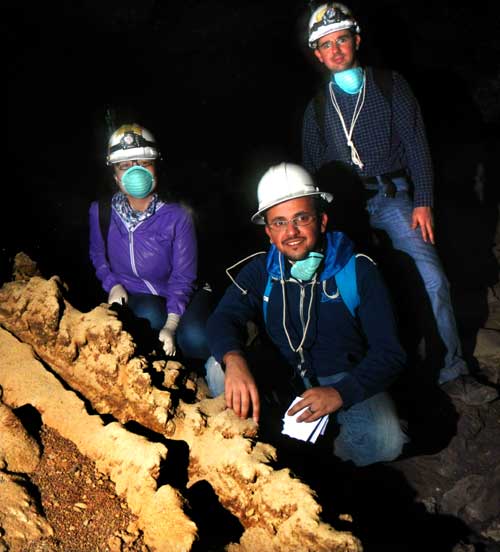 In 2009 I heard rumors that a new
university had opened its doors in Saudi Arabia. It was said that King
Abdullah University of Science and Technology (KAUST) was vibrant,
dynamic, staffed by the world’s greatest scientists teaching the
world’s most brilliant students, a truly international university which
its founder, King Abdullah, Arabia’s reigning monarch, envisioned as “a
bridge between people and cultures…and a beacon for peace, hope and
reconciliation.” In 2009 I heard rumors that a new
university had opened its doors in Saudi Arabia. It was said that King
Abdullah University of Science and Technology (KAUST) was vibrant,
dynamic, staffed by the world’s greatest scientists teaching the
world’s most brilliant students, a truly international university which
its founder, King Abdullah, Arabia’s reigning monarch, envisioned as “a
bridge between people and cultures…and a beacon for peace, hope and
reconciliation.”
Naturally I contacted KAUST, suggesting that Saudi Arabia’s caves—many
of which are over a million years old—would be ideal natural
laboratories for KAUST researchers to carry out projects and, quite
likely, discover new species of cave life while uncovering bones and
artifacts thousands of years old.
“We’ve barely opened our doors,” replied my KAUST contact, Dr. Sigurjon
Jonsson, a geophysicist from Iceland. “Give us a few years to get
organized.”
Finally, in 2012, I got the green light. “Come tell us about the
caves,” said Sigurjon, “during our Winter Enrichment Program in 2013.”
This WEP, I quickly learned, was an annual three-week event in which
students could attend presentations on almost any subject by the likes
of environmental advocate Philippe Cousteau, Swiss astronaut Claude
Nicollier and Egyptian archaeologist Zaki Hawass…and, this year, yours
truly, giving not only a course, but leading a field trip to a Saudi
lava tube as well.
So now, on January 10, 2013, I find myself in the middle of a 30-hour
journey from Guadalajara, Mexico to Thuwal, a fishing village on the
coast of the Red Seal, amazingly transformed into an enormous
university campus which is practically an independent city. KAUST has
kindly treated me to business class on Lufthansa Airlines and I am
having the time of my life, playing with my mechanized seat, which
converts to a “near bed” at the push of a button, but with vibrations,
whirrs and clunks suggesting this device is something between a
barber’s chair, a Transformer Robot and a trash compactor.
A mere 30 hours later, I am installed in a suite at the university’s
guest house. I step out onto my balcony and behold a scene right out of
the Arabian Nights: a vast promenade lined with palm trees, a majestic
mosque at one end and the glittering Red Sea in the distance. What a
place!
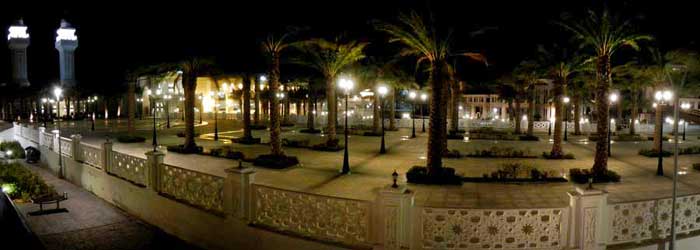
The next morning, jet
lag works in my favor, helping me to rise early and off I go to the
university dining hall, a ten-minute walk that immediately orientates
me to the world in which I have been plunged. Soaring structures of
extraordinary architectural beauty rise above me while hundreds of
students and professors on bicycles criss-cross my path and shoot past
me. This is a new-millennium university—and it’s co-educational: almost
as many women as men pass me on their bikes. Posters, billboards and
electronic signs remind me that it’s WEP time: Philippe Cousteau will
talk about the oceans, historian Sami Nawar will take us on a journey
through old Jeddah. I marvel at all this. These students come from
China, Brazil, Indonesia, Mexico and dozens of other countries,
including, of course, Saudi Arabia and the Middle East.
The students are all post-graduates and they came here to specialize in
their own careers, but this WEP is exposing them to widely diverse,
fascinating subjects well beyond their fields of expertise. This is
dangerous. What could happen? KAUST could easily give birth to a new
Renaissance Man…and Woman! WEP could turn half these cyclists into
Leonardo Da Vincis! My God, this university might even accomplish what
King Abdullah says he’s been dreaming about for years: a new birth of
scientific enlightenment in the Middle East, a flashback to those
fabled times when Arabs gave us Algebra, Alchemy and Astronomy and were
the only ones in the world who bothered to preserve the teachings of
Aristotle.
I muse on all these things while preparing my course on Limestone and
Lava Caves and the Secrets of Cave Photography. I am amazed that around
100 students show up for each of my PowerPoint presentations...
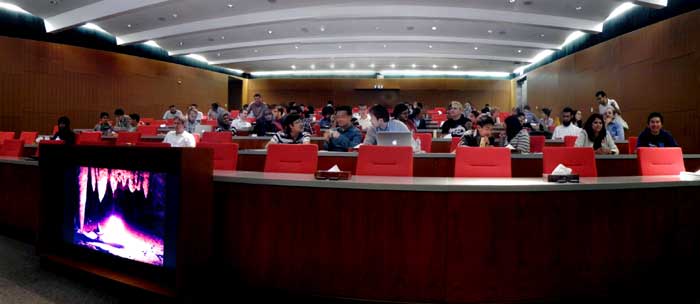
...I show them beautiful
caves decorated with gorgeous stalactites and stalagmites, ideal for
transformation into tourist caves.
I list the many artifacts and bones we have found, including part of a
human skull over 4,000 years old. I point out that there are at least 40
unexplored lava tubes located only 300 or so kilometers north
of KAUST, many of them up to 25 kilometers in length, housing who knows
what treasures placed there by early man 70,000 years ago. I casually
mention that no biologist, microbiologist or archaeologist has ever
studied these ancient caves, located so close to the very cradle of
humanity.
And now it is time for our field trip to Hibashi Cave. “Only 20
students can go,” Sigurjon tells me, “but there are over 100 on the
waiting list.”
Hibashi Cave lies 225 kilometers east of Mecca in the middle of a wide,
inhospitable lava field. It is probably the most celebrated cave in
Saudi Arabia today, as it was placed on the list of the World’s Ten
Most Important Lava Caves, due to the abundance of rare minerals found
inside it. On top of that, NASA collaborators at MIT are using Hibashi
as a model for a Martian lava tube, due to the meter-thick layer of
fine, powdery silt covering every inch of its floor. It’s this silt or
loess that forced us to limit the number of visitors to twenty-some. No
matter how carefully you move, this 5,000-year-old “dust of ages” soon
fills the air.
On January 16, the lucky twenty plus a few of us leaders meet after my
last course, ready to board our bus to the town of Taif and (tomorrow)
Hibashi Cave. Amazingly, our small group represents ten different
nations—we are a KAUST in miniature.
The bus appears on time, but, alas, with a window newly smashed by our
driver while making a tight turn.
“We’ll have to wait for a new bus,” announces Sigurjon. So we start our
journey 90 minutes late, but after an hour on the road, a student
shouts from the back of the bus: “Another window is about to fall off!”
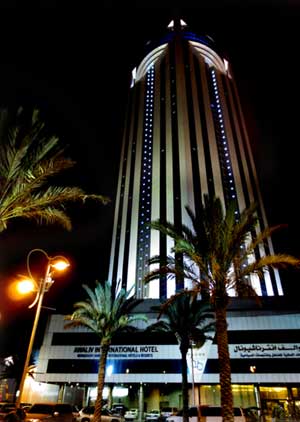 Ah yes, no matter what sophisticated project you
launch, whether in Saudi Arabia or Mexico, somewhere deep in the
infrastructure you just might run into primitive conditions which—as in
this case—usually respond well to primitive solutions. “Somebody hand
me the duct tape!” shouts Sigurjon as he climbs on top of a land
cruiser our driver has dangerously parked next to the bus, right in a
lane of fast-moving traffic. Ah yes, no matter what sophisticated project you
launch, whether in Saudi Arabia or Mexico, somewhere deep in the
infrastructure you just might run into primitive conditions which—as in
this case—usually respond well to primitive solutions. “Somebody hand
me the duct tape!” shouts Sigurjon as he climbs on top of a land
cruiser our driver has dangerously parked next to the bus, right in a
lane of fast-moving traffic.
As usual, duct tape saves the day, and in a few hours we are in Taif,
relaxing in the stunning Awaliv Hotel, where, the next morning, we
watch the sunrise from a revolving restaurant on the 29th floor. What a
view!
Our bus has been replaced by a third one with all of its windows
intact. We speed east through wide expanses of flat, volcanic rubble
toward a spot on the road where six land cruisers are waiting to
transport us over ten kilometers of rough, sandy tracks heading every
which way through tire-eating lava. I can only hope that the track I
recorded on my GPS nine years ago will actually bring us to Hibashi
Cave.
Suddenly there is a round of applause as our Bedu driver pulls up next
to a great, black gaping maw 14 meters wide. Hibashi Cave at last!
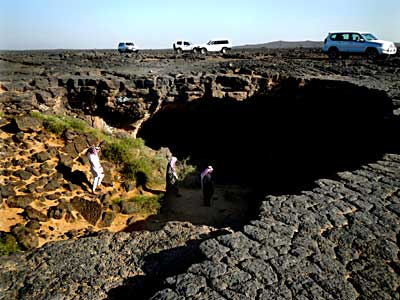
Sigurjon
passes out helmets, lights and face masks and soon we are all 26 meters
beneath the surface inside a passage darker than the darkest night,
decorated with lava stalactites and stalagmites and filled with animal
and human bones carried into the cave over the ages by hyenas, wolves
and foxes. The students have all chosen projects to carry out
underground, such as measuring the depth of the silt and collecting
samples of the cave’s soil, dove and bat guano and thousands of
perfectly preserved coprolites scattered throughout the cave’s 581
meters of passages. To see photos of these enthusiastic young
explorers in awesome Hibashi Cave, just amble over to
KAUST
Students Explore Hibashi Cave.
To
my great relief, a head count proves we have left no one inside the
cave and after a tasty meal of chicken kabsa, we begin the long drive
back to Jeddah and Thuwal.
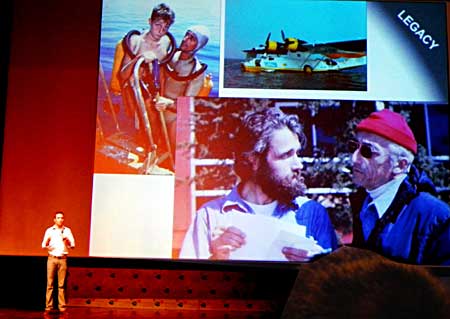 Two nights later, Philippe Cousteau,
who was raised by his grandfather, Jacques Cousteau, addresses a packed
auditorium at KAUST. He tells us about the “osteoporosis of the
oceans,” the result of carbon being absorbed by sea water, spelling
doom for shellfish, and he discusses successful solutions to oceanic
problems, such as Mexico’s Cabo Pulmo, which he calls “the best-managed
Marine Protection Area in the world.” And Cousteau also has a word to
say about KAUST, which invited him—and me, too—to participate in its
Winter Enrichment Program: “What an absolutely spectacular place!” he
says. “KAUST is a hotbed of ideas and potential.” Two nights later, Philippe Cousteau,
who was raised by his grandfather, Jacques Cousteau, addresses a packed
auditorium at KAUST. He tells us about the “osteoporosis of the
oceans,” the result of carbon being absorbed by sea water, spelling
doom for shellfish, and he discusses successful solutions to oceanic
problems, such as Mexico’s Cabo Pulmo, which he calls “the best-managed
Marine Protection Area in the world.” And Cousteau also has a word to
say about KAUST, which invited him—and me, too—to participate in its
Winter Enrichment Program: “What an absolutely spectacular place!” he
says. “KAUST is a hotbed of ideas and potential.”
I can only echo those words. King Abdullah’s dream seems to be turning
into reality.
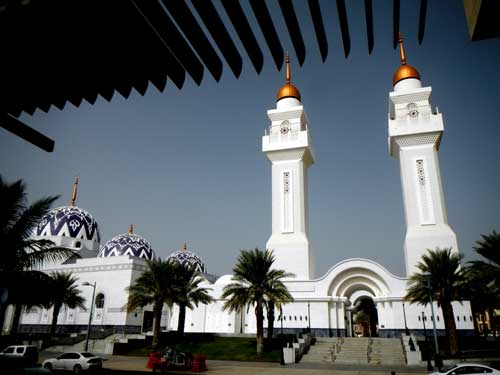
|

